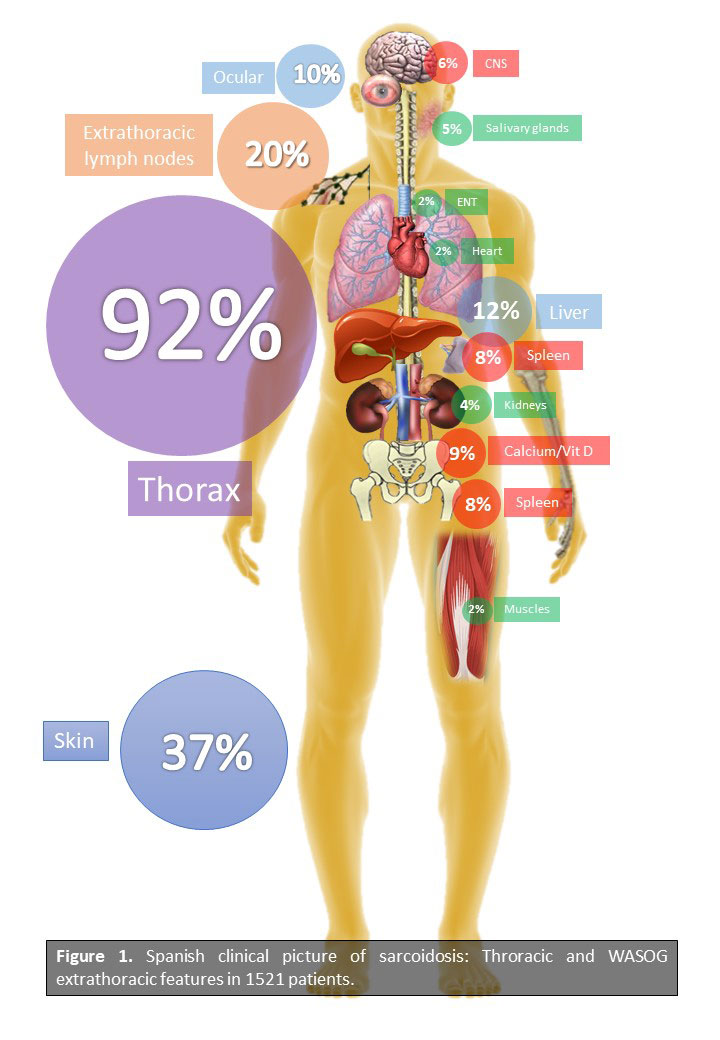Session Information
Session Type: ACR Abstract Session
Session Time: 4:30PM-6:00PM
Background/Purpose: To characterize the main epidemiological, clinical and radiological features at presentation of sarcoidosis in a large multicenter cohort from Southern Europe.
Methods: In January 2016, the Autoimmune Diseases Study Group (GEAS-SEMI) created a national registry (SARCOGEAS) of patients with sarcoidosis. Sarcoidosis was diagnosed in agreement with the criteria proposed by the American Thoracic Society/European Respiratory Society/World Association of Sarcoidosis and Other Granulomatous Disorders (WASOG) 1999 statement on sarcoidosis. Organ involvement was retrospectively determined in each patient at the time of diagnosis using the 2014 WASOG organ assessment instrument. Ethnicity was defined according to the FDA classification.
Results: The cohort consisted of 1521 patients (81% biopsy-proven), including 877 (58%) women and 644 (42%) men, with a mean age at diagnosis of 47.4 ± 15.2 years; 234 (15%) patients were born outside Spain. With respect to the FDA ethnic classification, 1370 (90%) patients were classified as White, 80 (5%) as Hispanic, 47 (3%) as Black/African American and 24 (2%) as Asian. Thoracic involvement was present at diagnosis in 1409 (92%) patients, including 427 (29%) patients presenting with stage I, 619 (41%) with stage II, 288 (19%) with stage III and 53 (3%) presenting with stage IV. Extrathoracic disease was reported in 1096 (72%), and systemic disease (defined as at least 2 extrathoracic organs involved) in 523 (34%). According to the WASOG classification, the most frequently reported extrathoracic involvements at diagnosis were cutaneous in 558 (37%) patients, extrathoracic lymph nodes in 309 (20%), liver involvement in 189 (12%) and ocular involvement in 156 (10%) (Figure). Potentially life-threatening WASOG involvements were reported in frequencies less than 10%, including neurological involvement in 98 (6%) patients, kidney involvement in 58 (4%) or cardiac involvement in 30 (2%). Need for systemic therapy was required in 756 (50%) and aggressiveness of therapy in 124 (8%). Therapeutic approaches at diagnosis included the use of oral glucocorticosteroids in 731 (49%) patients, immunosuppressive agents in 118 (8%) and biological agents in 22 (1.5%).
Conclusion: This is one of the largest series of sarcoidosis reported out of the US, predominantly composed by White patients in nearly 90% of cases. Clinical presentation is dominated by adenopathies (both thoracic and extrathoracic) and cutaneous features (erythema nodosum), with lower frequencies in the main extrathoracic involvements. However, extrathoracic disease was reported in 3 out of 4 patients, and one third of patients presented with at least 2 different extrathoracic organs involved. These findings underline the systemic clinical expression of sarcoidosis, being mandatory a multidisciplinary management of the disease.
To cite this abstract in AMA style:
Retamozo S, Pérez-Alvarez R, Feijoo-Massó C, De Escalante B, González-García A, Chara-Cervantes J, Gómez De La Torre R, López Dupla M, Alguacil A, Rascón J, Pérez-Conesa M, Bonet M, Robles A, Callejas J, Pinilla B, Fonseca Aizpuru E, Perez Guerrero P, Garcia Morillo J, de Miguel B, Akasbi M, Ojea Varona S, De La Red Bellvis G, Calvo Begueria E, Gómez Cerezo J, Soler i Ferrer C, Gutiérrez De Ceballos E, Cruz-Caparrós G, Rodríguez Fernández S, Gato Diez A, Morcillo C, Ojeda I, Vives M, Penadés Vidal M, De Vicente M, Kostov B, Pallarés L, Brito-Zerón P, Ramos-Casals M. Sarcoidosis as a Systemic Disease. Clinical and Epidemiological Characterization of Systemic Phenotype in 1521 Patients [abstract]. Arthritis Rheumatol. 2019; 71 (suppl 10). https://acrabstracts.org/abstract/sarcoidosis-as-a-systemic-disease-clinical-and-epidemiological-characterization-of-systemic-phenotype-in-1521-patients/. Accessed .« Back to 2019 ACR/ARP Annual Meeting
ACR Meeting Abstracts - https://acrabstracts.org/abstract/sarcoidosis-as-a-systemic-disease-clinical-and-epidemiological-characterization-of-systemic-phenotype-in-1521-patients/

